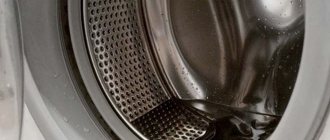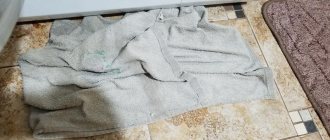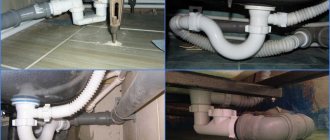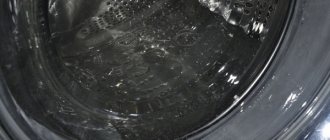Your toilet may surprise you in many ways, but the worst thing is the rise in water level after flushing. If you notice that the water in your toilet is rising too high when flushing, you must react quickly to avoid overflowing.
The most important task is to determine the reason why the water level is rising so much. This could be a partially clogged toilet, a faulty system, or debris in the vent, a clog. Each problem requires a different approach, so keep reading to learn how to prevent your toilet from overflowing.
Air lock is the cause of stagnation of drains
An air lock formed in the sewer system of a house can also disable the operation of the sewer collector. The air that has stopped in the system simply prevents the drains from leaving through the riser and either returns them back or passes them through, but very slowly and at the same time throws sharp unpleasant odors into the room.
The reasons for the formation of an air lock in the sewer can be as follows:
- Mistakes made when installing a plastic manifold (insufficient tightness of the pipeline, lack of connecting fittings, etc.);
- Excessive manifold turns, incorrect pipeline drops or incorrectly selected elbow angles;
- Lack of a water seal in the installed sewage system;
- Possible blockage or icing of the drain pipe in the attic or roof area.
Hydrodynamic pipe cleaning
If all known means are ineffective, it is recommended to use a special technical device with which hydrodynamic cleaning is carried out. This method is considered very effective.
Such machines differ in power and overall dimensions. It is allowed to clean pipes whose diameter can be 5-100 cm.
As a rule, all hydrodynamic devices operate on the same principle, regardless of their power and size. A nozzle is placed on the end of the device, through which a stream of water is supplied under high pressure.
The flexible hose ensures maneuverability of the device, which is important for achieving a positive result.
Some people often wonder whether it is possible to use such equipment at home and what are the costs? In answering these questions, it should be noted that to clean the sewer system in an apartment it is not necessary to buy special equipment. It’s easier to call a specialized organization. If there is a need or your financial situation allows, you can buy a mini-device for use in a country house.
Air lock problem
Nowadays, plastic pipes are very popular, which are distinguished not only by good performance characteristics, but also by easy installation. Not everyone who installs plastic pipes is a specialist, so when choosing consumables for installing a sewer system, various types of mistakes can be made. Common mistakes when choosing and installing a system include:
- incorrect determination of pipe diameter;
- unnecessary turns during the installation process;
- laying sewer pipes at the freezing level of the ground;
- lack of means in large areas to control the operation of the system.
The most difficult issue to resolve is that of an air lock in the sewer; not everyone knows how to fix this problem. If it is serious enough, then there may be a need to rebuild the entire sewer system. Before making such drastic decisions, you need to try to eliminate the problem yourself, using some simple methods.
How to get rid of an air lock?
If an air lock appears in a specific section of the pipe, for example, in the sink drain in the kitchen, bathroom or toilet, the essence of the problem may be:
- in the farthest location of the plumbing fixture from the riser;
- due to an installation error when pipes were installed with the wrong slope.
To solve such problems, you can simply re-lay the sewer sample to the riser, taking into account the correct level of inclination. In some situations, it is enough to simply raise the plumbing fixture to the required level. Thus, due to the level difference, you can get rid of problems with an air lock.
If there is an air lock in every plumbing fixture, then most likely the design of the air duct was not thought through during the installation of the system. In such a situation, it is recommended to make an open sewer riser on the roof, through which air is released from the pipeline. If this is not possible, you can install air valves that can allow air to flow in one direction.
There are situations when an air lock forms during the installation of an air duct. Then you need to check its performance.
If the measures taken to eliminate the air lock in the sewer are not successful, then the only solution is to lay new pipes.
Conclusion
To eliminate a malfunction in the toilet, including such as an increase in the water level in the bowl, it is first necessary to establish its cause. If it is associated with a normal blockage, then in most cases you can eliminate it yourself. More complex problems should be dealt with by specialists.
From the video in this article you can get additional information on this topic.
Did you like the article? Subscribe to our Yandex.Zen channel
Types of sewer clogs
If the sewer system in a house is operated in violation of all the rules for its use, then over time, blockages and plugs inevitably appear in the collector, which impede or completely stop the flow of wastewater. As a result, either someone from an apartment building or the owners of a private building will suffer from at least an unpleasant odor in the living space. The maximum possible flooding of the kitchen or bathroom with fecal water. This is not very pleasant, so to avoid such situations you need to use the collector correctly, namely:
- It is strictly forbidden to flush used personal hygiene items, such as pads, diapers, tampons, etc., down the toilet. Only flushing toilet paper is allowed.
- It is prohibited to flush bulk construction mixtures such as cement, sand, chalk, clay, etc. down the drain.
- Accidental flushing of rags and other similar items down the drain should be avoided.
- It is advisable to install grease traps in the kitchen, which will prevent the deposition of heavy greasy deposits on the walls of the collector. This, in turn, can create fecal growths-stalactites in the system and impede the flow of gray water.
It is always worth remembering that a traffic jam can form either in a specific place in the sewer system in an apartment or in a private house, or at any point in the central riser. If the last option is checked, then the drains will have nowhere to go but to return back from the blockage under the influence of hydraulic force. As a result, fecal or gray water will try to escape through the unoccupied openings of the bathtub, sink, and other plumbing fixtures.
What should I do if liquid fills the bowl when the drain tank is closed?
If the water rises not only after draining, but even with its supply to the tank shut off, then the blockage is located directly in the riser. In this case, you need to contact the management company (MC), since the central riser belongs to the common property of the residential building.
In case of inaction of the management company it is necessary:
- draw up a report on flooding of apartments in the building;
- contact an expert institution to conduct a construction and technical examination;
- go to court with claims against the Criminal Code.
Ways to solve the problem
Tools and materials to fix the problem:
- chemicals;
- plunger;
- special cable.
Use of chemicals
When using household chemicals to clear a clogged toilet, you must strictly follow the instructions and not exceed the specified dosage
. Use a substance specifically designed for cleaning pipes, for example, “Mole.” Typically, such products are made based on alkalis. The substance is poured into the toilet and begins to corrode the plug of debris and sewage that has formed inside the pipe. After falling asleep, for the procedure to be effective, you must not use the toilet for its intended purpose for several hours.
plunger
This is the simplest tool, the principle of which is to create the movement of a mass of water inside the pipes and toilet. Like a pump, a plunger pulls out some of the water and debris that has accumulated inside. The lump of plug collapses, a small gap is formed inside the drain pipe, the liquid rushes down the drain, taking with it all the debris.
Cable
The hydraulic method of removing blockages is extremely effective if the plug is formed by fatty deposits.
Most plumbers use a cable to solve this problem. It is pushed inside the toilet drain hole and pushed further along the pipe. During the process, the cable is rotated around its axis. When its end rests against the plug inside the pipe, as it rotates, it begins to twist inside the lump of debris, like a corkscrew. When the end of the cable has slightly entered the plug, when moving back and forth, the plug moves out of place and is partially destroyed. This is enough to clear the blockage inside the pipe. Afterwards, the plug is either washed down the pipe with a mass of water, or is removed out along with the cable.
If the problem is not a clogged sewer, but an incorrect design of the toilet or pipe laying, a full repair cannot be avoided.
With the help of simple manipulations, you can independently solve the problem of water obstruction in the toilet. However, if the blockage cannot be resolved using the methods listed above, you may need the help of a plumber.
Water seal failure
Apartment residents often experience problems with the water seal, which is accompanied by gurgling in the toilet and the spread of an unpleasant odor throughout the room. In order to eliminate them, you first need to figure out why the water is gurgling in the toilet.
The reason for the phenomenon is contained in the malfunction of the ventilation of the sewer system. Since, while the apartment located higher up the riser is draining, the drains falling downwards increase the pressure in the system up to a certain point, after which they lead to a vacuum in it.
Pressure changes lead to the fact that the water seal in plumbing devices “breaks”. This is what causes such troubles as gurgling. In some cases, this process may also be accompanied by splashing water.
But what should you do if the air blows water out of the toilet or the water level in the toilet drops after the next “gurgling”? The only way to solve the problem is to return ventilation, which will compensate for pressure drops.
First of all, you need to contact the experts to clean the drain pipe supplying the ventilation. You are not allowed to carry out such work on your own.
Related article: Cleaning the toilet at home
It must be stated that there are cases when, in addition, after the restoration of ventilation is completed, the problem of a water seal failure is not completely resolved. This is due to the increase in the number of plumbing fixtures in apartments. Under such conditions, you need to install a special air (vacuum) valve.
The principle of operation of the device is based on the fact that it normalizes the pressure in the system during drainage, as a result of which the water seals remain intact. If necessary, it is also possible to install a pair of such valves, placing them near plumbing fixtures.
Note! The vacuum valve must be installed 10-15 centimeters above the highest point of connection between the plumbing fixtures and the sewer system. This requirement must be met to avoid flooding of the valve.
These are, perhaps, all the most common troubles of the sewer system that you sometimes encounter during the operation of the toilet and other plumbing devices. They are especially often seen in dilapidated buildings, where pipes are often clogged or simply not designed for many plumbing fixtures.
Why does the sewer freeze?
Reasons for freezing sewer pipes:
incorrect design of the angle of inclination of the sewer pipeline. Water is not able to move by gravity and stagnates in the pipes, which leads to freezing in the winter;
insufficient burial depth. According to SNiP, the septic tank is installed at a depth of at least 2 meters from the soil level, the pipe system is located below the freezing point characteristic of the region. But a situation is possible when you are simply too lazy to dig a trench for laying pipes deep (or there is no possibility) or frosts exceed the average and the soil freezes deeper;
lack of insulation. Sewage pipes laid above the freezing point of the soil require insulation. The place where pipes exit the room must also be insulated. However, in practice, such a requirement is either ignored, or an unsuitable thermal insulation material is used, or its installation is carried out incorrectly;
small pipe diameter. If we consider consumer reviews, then most often those who have laid pipes with a diameter less than the recommended 110 mm are faced with the problem of sewerage freezing. Owners of summer cottages and houses that are used seasonally are especially often guilty of this. Due to insufficient diameter, the sewer pipe freezes faster;
blockages. They happen due to large objects getting into the system or insufficient water flow, which causes plaque to form in the pipes.
Causes of septic tank freezing:
The drainage from the septic tank is broken. In this case, the septic tank overflows, heavy fractions settle, and the water freezes;
the septic tank is removed from the source of wastewater. Then the water, moving to the waste pit, cools, which leads to its freezing at the junction of the pipe and the septic tank.
Many users who do the work themselves do not even think about whether the sewer system is freezing. After all, the very principle of operation of a septic tank is that it is a container for storing wastewater with actively occurring decomposition processes. Since heat is released during the decomposition of solid residues, freezing is practically excluded. In addition, according to standards, the septic tank is installed at a considerable depth.
However, no one is insured against force majeure, and it is better for the owner of a country house to know in advance what to do if the sewage system is frozen.
Clogged sewer pipe
To effectively remove a blockage that has formed in a sewer system pipe, you need to buy a product containing chlorine from a specialized store. To use the drug to solve the problem of how to eliminate the smell in the toilet, you must strictly follow the instructions on the bottle so as not to harm your health. The product must be poured into the drain hole and left for a while. Most often, the blockage dissolves under the effective influence of a modern household product, and the plumbing fixture begins to function normally. If a household chemical product turns out to be ineffective, then you need to use the services of a plumber to clean the pipe.
The water rises up when flushing, and then slowly goes away
Signs of a clogged toilet are difficult to confuse with something else, since in this case, when flushing, the water level rises sharply , but slowly decreases to normal.
This means that the toilet elbow, which is connected to the central riser, is clogged with debris, such as a large amount of toilet paper or hair.
Even without flushing, nothing leaks from the toilet
If the level in the toilet rises even if it is not flushed from the tank, then the problem is in the central riser , and the situation must be corrected as soon as possible, otherwise a flood may occur.
How to clear the blockage?
If the liquid rises up after draining and then slowly leaves, then the problem lies in a normal blockage, which can be eliminated yourself.
Photo 1. Using baking soda and table vinegar, you can clear a simple blockage in any plumbing fixtures.
Using baking soda and vinegar
Every housewife has baking soda and vinegar in her kitchen. To clear the blockage using these available means, you need to perform the following steps:
- Scoop out excess fluid from the toilet, leaving some in your knee.
- Pour 1/2 a pack of soda (about 250 grams ) into the toilet and push it deep into your knee.
- on top .
- Wait approximately 15 - 20 minutes for the reaction to complete.
- Rinse off the soda and vinegar with boiling water or just hot water.
Important! Do not use boiling water if the connecting corrugation is made of thin plastic, as a crack may appear on it.
Specialty chemicals
a large number of toilet cleaning sold in stores The most common of them: “Mole”, “Tiret”, “Mr. Muscle”, “Floop”. They will clear the blockage and help get rid of anything that has accumulated inside the pipes, for example: hair, grease, salt, limescale.
Reference. Special chemicals are suitable for mild blockages that are only at the initial stage.
Using a plunger
If there is a clog in the toilet elbow that can be pushed through, then using a plunger may be appropriate.
Under the pressure of air and liquid, the garbage plug will be pushed into the central riser, which is much larger in diameter, and will float freely into the sewer.
It is important to remember that the diameter of the rubber suction cup must be larger than the drain hole itself.
Using a “doll” to break through a garbage plug
This homemade device is often used by plumbers to get rid of blockages. To make a “doll” you will need metal wire and a small bag of sand, which is attached to this same wire. The wire needs to be bent to the shape of the toilet elbow, and the resulting blockage should be pushed through
Defrosting sewerage work procedure
If a problem arises and the sewer system in a private house is frozen, you must first determine the location of the ice jam.
Craftsmen note the importance of following the order of work, and it is better to start from the place where the water exits the septic tank. This order of work is due to the fact that the sewer pipe system is designed with the obligatory condition of ensuring unhindered flow of water
This means that all pipes, incl. The drain pipe is located at a slope to the exit point.
Ice plugs must be melted so that the water can drain naturally. Otherwise (when performing work outside), you need to be prepared for the drains to flow in the opposite direction, which will necessitate pumping them out. This convincingly proves that work should begin in the direction from the septic tank to the internal pipes.
But there are exceptions to this rule. Ultimately, the order of work will be determined by factors such as:
the location where the ice plug forms. If the water is frozen in the inside of the sewer (unheated house), then it will be much easier to defrost;
cork sizes. Perhaps the size of the ice plug will be only a few centimeters, then the volume of water that needs to be pumped out can be neglected;
geometry of the sewer system. The more straight sections in the system, the easier it is to remove the ice plug;
laying method. Typically, sewerage is located underground. And if ice has formed in pipes located at a sufficient depth under a layer of frozen earth, the number of options for use is sharply reduced. You can’t get through the septic tank - you have to carry out work from inside the house.
The easiest way to organize the winter functioning of the sewer system is to contact specialists who provide sewer defrosting services. The craftsmen not only know how to defrost a frozen sewer, but also have special equipment and also provide a guarantee on their work. However, for various reasons, many people prefer to solve the problem on their own. And as reviews from forum members testify, it was quite successful and fast.
Water seal failure
Often, apartment residents experience trouble with problems with the water seal, which are accompanied by gurgling in the toilet and the spread of an unpleasant odor throughout the room. To eliminate them, you first need to figure out why water is gurgling in the toilet.
The reason for this phenomenon is a malfunction of the ventilation of the sewer system. After all, when an apartment located higher up the riser is drained, the drains falling down increase the pressure in the system up to a certain point, after which they cause a vacuum in it.
Pressure changes lead to the fact that the water seal in plumbing fixtures “breaks”. Hence such troubles as gurgling. In some cases, this process may even be accompanied by splashing water.
But what should you do if the air blows water out of the toilet or the water level in the toilet drops after another “gurgling”? There is only one way to solve the problem - to restore ventilation, which will compensate for pressure drops.
First of all, you need to contact specialists to clean the drain pipe that provides ventilation. It is prohibited to carry out such work on your own.
It must be said that there are cases when, even after restoration of ventilation, the problem of water seal failure is not completely solved. This is due to the increase in the number of plumbing fixtures in apartments. In this case, it is necessary to install a special air (vacuum) valve.
The principle of operation of the device is based on the fact that it normalizes the pressure in the system during drainage, as a result of which the water seals remain intact. If necessary, you can even install several of these valves, placing them near plumbing fixtures.
Note! The vacuum valve must be installed 10-15 centimeters above the highest point of connection between the plumbing fixtures and the sewer system. This requirement must be observed to avoid flooding of the valve.
These are, perhaps, all the most common problems of the sewer system that you encounter from time to time during the operation of the toilet and other plumbing fixtures. They are especially common in old houses, where pipes are often clogged or simply not designed for a large number of plumbing fixtures.
Related article: How to fix a cistern
Ways to fix sewer problems
In order to try to remove a blockage in the sewer drain of an apartment or house, you must first determine the location of the blockage.
So, if a problem with water outflow is observed in the kitchen sink, and all other drain points are working normally, it means that the garbage plug has formed specifically in the siphon under the sink. In the same way, you can identify blockages under the sink in the bathtub or under the bathtub/shower stall itself. Depending on the location of the plug, chemicals such as “Mole”, etc., can be poured into the drain hole in accordance with the instructions and eliminate the problem of deposits on the pipes.
- As an aggressive anti-clog agent, you can use simple soda mixed with hot water. That is, first pour soda into the hole in the bathtub or sink, then fill it with hot water. After this, vinegar is poured into the hole. The reaction of the components should push the plug or simply liquefy it.
- You can also use a standard plunger to remove a blockage in your home drain. Cleaning is easy with it. You need to fill the plumbing fixture with water and tightly cover the drain hole with a plunger. Now you should make rhythmic movements up and down with the plunger, creating a vacuum in the manifold. Under its influence, the plug should either come out (most often it is hair) or go into the waste system. You can clean the sink and toilet in a similar way.
Loose stools. What to do
If you have soft, too frequent, loose stools for a long time, this indicates a malfunction of the gastrointestinal tract. To get rid of diarrhea, you need to understand the cause of its occurrence. Try to strengthen your stool with foods that strengthen it. These are unripe bananas, applesauce, rice, fatty meat, broth, baked goods, mashed potatoes.
An excellent home remedy for diarrhea is black peppercorns. Depending on your body weight, take 10-15 pieces and swallow with water.
When diarrhea continues for more than three days or there is blood in it, you need to consult a doctor and have a detailed stool test done.
How and how to defrost a sewer in a private house
There are different ways and means to warm up a frozen sewer (than to melt the ice in a pipe). All methods can be combined into two large groups:
thermal method. Provides for the organization of heat supply to the freezing point. The work is progressing slowly, but there is no risk of causing damage to the pipeline system. This method is most suitable at home, when special means are not at hand, and calling specialists is impossible or too expensive;
chemical method. Currently, chemical defrosting is rarely practiced. Firstly, because not every chemical can cope with icing. Secondly, because this is a costly method. And thirdly, because many users prefer local sewers, i.e. systems that are capable of performing partial wastewater treatment.
Mellerud pipe cleaner, chemical defrosting One of the components of local systems is the presence of biological treatment, and chemistry can negatively affect the life of bacteria. However, its simplest variety, a steep saline solution, is still used, according to reviews.
A more technologically advanced option is to use a drug like Mellerud. The components of Mellerud pipe cleaner react with water to produce heat.
Note
You should carefully use a chemical method to defrost plastic sewer pipes. Because
Severe overheating can cause them to deform.
Damage to the enamel inside the toilet bowl
If the enamel surface inside the plumbing bowl is rough, or scratched, or there are cracks or chips, all this may be the cause of poor flushing of the toilet. In such cases, experts recommend thinking about buying new plumbing fixtures. But if for some reason you are unable to purchase a new toilet, you can repair the old one.
For this you will need:
- special putty (can be replaced with waterproof sealant), which is suitable for ceramic surfaces;
- powder paint;
- spray gun.
Once you have purchased the necessary material and tools, you can begin repairing plumbing equipment. To do this you need to do the following.
First, you need to clean and degrease the surface of the toilet bowl (from the inside). Secondly, places where there are cracks and chips should be cleaned with sandpaper (preferably fine-grained).
After this, all problem areas must be covered with putty or sealant. Wait for the putty to dry well before painting the surface.
Even if you have restored old plumbing, you still need to think about buying a new toilet. Because painting a ceramic surface at home cannot be compared with factory enameling. In addition, such a coating will not last long, and the toilet will again begin to flush poorly.
What kind of blockages can there be and how to determine their cause
All sewer blockages are divided into several types:
- adhesion of fat to the internal surfaces of the pipe and adhesion of other waste. Such a blockage is usually called operational;
- the mechanical appearance differs from the previous one in that the cause of clogging is the entry of a foreign object into the system;
- as a result of the appearance of a fatty layer, a siphon blockage may occur;
- There is also a man-made problem, the cause of which is an error during installation of the system.
If the main access riser on the lower floor becomes clogged, then all the contents in the pipe rise up and come out in someone’s toilet, bathroom or kitchen. In such situations, you need to urgently call a specialist, since it is unlikely that you will be able to fix the problem yourself.
Finding an air lock in a sewer pipe
Ways to solve the problem
You can use regular soda to clean drains. To dilute the correct solution, you need to prepare several liters of boiling water in which a pack of soda will dissolve. The prepared liquid should be poured into the drain hole, and it is recommended to gradually add vinegar. In this way, a reaction can be achieved that will promote the rapid decomposition of fat
Most often, this method is used if there are no special means at hand, which include Mole, Tiret, etc. You can use chemicals yourself, but it is important to follow basic safety rules. Immediately before cleaning the sink, toilet or bathtub, you need to familiarize yourself with the operating instructions for a particular product.
It is better to use this cleaning method when the pipe is not yet completely clogged, this way you can achieve greater efficiency. When the drain is completely clogged, it is dangerous to use chemicals because they can back up into the bathtub or sink. A proven and reliable method of cleaning is to use a simple plunger. When actions using soda or chemicals do not bring much effect, then this method can be used. In such cases, it is important that the bowl of the plunger completely covers the drain hole.
How to fix the problem using a plunger?
Actions are performed in a certain sequence:
- a sample filter is removed from the hole;
- the top hole of the bathroom must be tightly closed to achieve greater efficiency during the work process;
- The plunger must be installed so that no air lock appears, while the handle is placed vertically;
- without lifting the device from the bottom of the bathtub, you need to move the device up and down;
- on the last movement, the plunger rises from the water to check the effectiveness of its drainage. If necessary, the procedure is repeated several more times.
Another proven device is a metal cable, which is often used by plumbers. At one end of such an object there are fluffy wires, on the other side of the cable there is a handle for convenient use. The first end is inserted into the pipe, and rotational movements must be made using the handle. Depending on the degree of pipe clogging and the location of the problem, cleaning can take a relatively long time. If the problem is solved quickly, then the length of the cable is sufficient to effectively penetrate the sewer.
Types of faults
Water in the plumbing may not flow through for only one reason - a clogged sewer. However, in order to fix the problem, you need to figure out why the water is rising in the toilet, or more precisely, where it is coming from.
There can only be two options:
- Drains from the cistern.
- Comes from the sewer.
Below we will look at how to stop the water in the toilet in both cases and remove the blockage.
Removing a blockage using a plunger
Normal clog
If you are faced with a regular blockage, and water enters the toilet from the flush tank, then you should first turn it off to avoid overflow. Why there is water in the toilet is clear to everyone; it all comes down to a blockage in the system.
At the same time, many people do not think about what to do if there is water in the toilet, but immediately call a plumber. As a result, you have to wait a long time for their arrival and pay for the work done.
Therefore, in most cases, it is more advisable to remove the blockage with your own hands, for example, using an ordinary plunger.
This is done as follows:
- The bowl of the plumbing fixture is filled with water so that its level covers the drain hole.
- For greater efficiency, drains and overflows of nearby plumbing fixtures (bathtub, sink, etc.) are closed.
- Then a plunger is placed over the drain hole, and it should completely block the drain.
- After this, several active pumping motions are done.
- If after this the water in the toilet begins to swirl and gurgles into the drain, it means the blockage has been removed.
- If the water does not leave the bowl or begins to leave slowly, the operation should be repeated several more times.
- After the blockage is cleared, you need to pour a pan of boiling water into the system.
If you can’t solve the problem with a plunger, you can use special chemicals to clean the drain. The price of such drugs is quite affordable, so anyone can clean the system in this way.
Drain cleaner
The only thing when purchasing a product is to pay attention to what type of pipes it is intended for. This information is contained in the instructions on the packaging.
If the product is incompatible with your type of pipes, it may further damage the sewer system.
Another way to remove a blockage is to use a plumbing cable, which is inserted into the sewer through the drain hole and at the same time rotated slowly. It must be said that cleaning with a cable is the most effective.
Scheme for cleaning a toilet with a plumbing cable
Blocked riser
Now let's look at what to do if water rises in the toilet when the flush cistern is closed. Let us immediately note that this malfunction is more serious and unpleasant, since it is impossible to independently prevent the flow of water into the toilet.
The reason for this is that the sewer riser is clogged below the level of your toilet. As a result, according to the principle of communicating vessels, all drains will rise up into your toilet through outlets and can flood the apartment.
Therefore, if such a problem is discovered, you must immediately contact the appropriate authorities, and also go around the neighbors living higher up the riser with a request not to use the plumbing until the problem is fixed.
Check valve for sewerage
Advice! Installing a check valve will prevent your apartment from flooding with sewage. This device is especially relevant for residents of the first floors of high-rise buildings.
Other interesting questions and answers
What happens if during a fire you close yourself in the bathroom and, opening the water, flood everything around you?
Alina Boldt3
Makes a good broth
Well, in order to fill out 140 characters, I can advise you to pour salt and spices to taste into the bath in advance. You can throw in a bay leaf.
Nekit Ganbarov118
How do you feel about those people who left your life? And were there such people?
Guest7
Well, it depends on what kind of people, if they didn’t mean much to me, then I treat it calmly, and if they were my everything, then tears and tears and tears. Yes, there are quite enough of such people, but still this is life, and this will happen all the time. We’re not in the right to hold someone back and force them to stay with us if they no longer want it. Of course it will hurt, because when a loved one leaves, it feels like a part of you is simply dying. It’s like you’re broken and don’t feel anything. But with time it will pass. Maybe. everything has to pass someday. but in order for people not to leave, you just need to appreciate them and give yourself to them completely, simply because one day this person will not be around, and you will be ready to give everything, just to once again, at least for feel him next to you for a couple of minutes, smell him and just hug him and tell him how important he was to you. ummm61
Why does the bathtub occasionally smell like sewage?
There are no blockages in my apartment bathroom. The house is five-story. I live on the fifth floor. I contacted the plumbers, but they didn’t really say anything. You can hear the flushing in the riser on the lower floors, and the gurgling in the pipes in the bathtub. They explained that this was due to the automatic washing machine. I can't understand this connection. How to write an application, what exactly do you require?
P.S. Men, please tell me what to do?
nikumarina20112
I'm not a man, but I'll give you a hint. I live on the fifth floor, and this sometimes happens. My husband and I have been looking for the reason for this phenomenon for a long time, but it turned out to be quite simple and well-known. You can observe (or rather smell) this phenomenon only in winter, during severe frosts. It is also typical for the 4th floor, and indeed for the upper floors. This is due to the fact that sewer flows are uneven. At night, practically no one drains the water, especially warm water. Everyone is asleep, as you might guess. And those drains that are present carry mainly cold water from the cisterns. If the frost is severe, then a small amount of ice will form in the lower sewer pipes. The cross-section of the pipe opening decreases. When water is drained, this leads to a flow of air following its flow. He, like a vacuum cleaner, sucks out the water standing there from the knee under the bathtub or sink. It serves as a water seal and prevents the penetration of odors from the pipes. You simply don’t notice it, but you immediately smell it. As the air gradually heats up, it rises up through the pipes and comes out of the drain hole of the sink or bathtub. In the morning, people start pouring warm water, and everything returns to normal. To avoid this, you just need to drain some water into the sink or bathtub in the evening. Literally a couple or three glasses. If the water drains relatively slowly, it will not go down the drain, but will remain in the water seal, where it should be. There will be no smell. Tested many times.
Andreeva6
I am very nervous when the gases in my intestines begin to boil, drill, jump and scream heart-rendingly...
I noticed that this happens to some people when they want to go to the toilet.
But for me it’s always whether I went or didn’t go, it doesn’t matter... If there’s a person nearby, that’s it... Run for your life. Otherwise, such a symphony will begin that it will be heard at 50 meters
And I'm not kidding. Why do I need this? And how can I get rid of it? As a result, I am tormented by a bunch of complexes and blocks. I avoid people myself so as not to embarrass myself once again. I sit at home and suffer... And they consider me abnormal. I was poisoned by worms. I took strong drugs. But nothing has changed. Guest5
I tried not to eat foods that caused gas. Also this year I took a course of Normobact. The result turned out to be pleasant, I can now eat a pickled cucumber with dinner and a cabbage salad
Guest1
Methods for eliminating air locks
Removing plugs using an installed air vent
Before removing the air lock in the heating, you need to find out its properties. The main one is density, which will always be lower than the same indicator of water. Accordingly, the liquid will displace air upward and in the direction of circulation.
Therefore, to remove air, it is necessary to ensure the release of steam. To do this, you should install special devices - air vents and Mayevsky taps. They work on the principle of a check valve. When a certain pressure is exceeded, steam acts on the valve seat. The rod moves, releasing air from the radiator or pipe. After the pressure normalizes under the action of the spring, the rod takes its old position.
An air lock in a cast iron or aluminum radiator can damage the housing. Therefore, when such a situation arises, you need to solve the problem immediately.
Reasons for the formation of air jams
The finished closed-type heating system is sealed, but this does not guarantee the absence of air bubbles. Where does the gas in pipes and radiators come from?
Air appears in the heating system for the following reasons:
:
- The coolant is tap water that has not undergone special preparation - when heated, air dissolved in the water begins to release, and plugs form from small bubbles.
- The tightness of the system is broken, and air is gradually sucked in through loose connections.
- During the repair work, part of the circuit was disconnected by shut-off valves, some elements were replaced or cleaned, and then the coolant was again supplied to the repaired circuit.
- The pipeline was laid in violation of standards - the small angle of inclination of the pipes and improper installation of kinks prevent gas bubbles from entering special devices - air vents. As a result, gas accumulates in problem areas and interferes with the normal circulation of the coolant.
- If the heating system of a private home fills up very quickly (or when the coolant supply is not at the lowest point), the liquid is not able to completely displace air from complexly configured places in the pipeline and radiators.
- Air vents are missing or incorrectly positioned. Also, the reason for the incorrect operation of the air bleed device is its contamination by mechanical inclusions in the unfiltered coolant.
Separately, it is worth considering gas formation in aluminum radiators. When metal comes into contact with a slightly alkaline coolant, hydrogen is released, which accumulates at the highest point of the heating device. If the radiator is not equipped with an air vent, over time the gas lock will not allow the coolant to pass freely through the internal channels of the heating device.
The tank does not fill
The float valve is clogged. Water carries with it mineral salts, sand and scale dissolved in it. Sooner or later, the bottleneck - the valve nozzle - inevitably becomes overgrown.
Advice: a coarse filter immediately after the valve will not remove salts from the water, but will retain all large suspended matter and sand.
- Turn off the water to the tank.
- Pull out the pin that holds the float lever.
- Pull out the lever and valve that shuts off the water.
- Clean the nozzle located behind the valve with a thin wire. Then turn on the water for a short time so that the remaining sand and lime is washed away with water. If the valve becomes clogged with debris again during flushing, clean it again.
- Reassemble the float valve in reverse order.
The photo clearly shows the nozzle that we need to clean. Of course, it is not necessary to remove the valve.
Bleeding air in radiators
So, first of all, you should focus on bleeding air from heating devices - radiators. In this case, you should use the already proven option: bleed the air through the Mayevsky valve. This tap is usually installed instead of blind plugs on the radiator, at the highest point. This arrangement implies the accumulation of excess air directly under the valve. In other words, when it opens, the first thing that will come out is air, and then water will come out, which will indicate that the plug in the heating system has been completely eliminated.
To do this, you just need to place a container into which a small amount of liquid will be poured out along with the air. Open the tap and wait until only water comes out, without the characteristic sounds of air bubbles.
Correction of design features of plumbing fixtures
Water may drain slowly from the toilet because there is not enough water in the tank. Insufficient volume will not create the required pressure and speed for passage through the pipes. To fix it, you need to adjust the tank filling mechanism to an acceptable level.
One of the reasons may be a poorly adjusted mechanism
The amount of liquid may be sufficient. But due to debris trapped in the drain, as well as deposits of mineral salts on the parts, the passage of water may be difficult. The result is the same. A strong flow when opening the valve becomes impossible, and water will slowly flow through the toilet. Mechanical cleaning will help restore functionality. You can also use active chemistry.
If you buy an outwardly beautiful Chinese fake, be prepared that the internal diameter of the drain neck of such a toilet may be extremely small. There is no way to fix this. Therefore, the best way out would be to buy a new toilet. But already from a trusted manufacturer.
Heating system without air locks
To ensure that air in an individual heating system does not accumulate in problem areas, but goes outside, it is necessary:
- correctly design and install the pipeline, correctly install radiators;
- use automatic and manual air vents.
Let's look at how to expel air from a heating system with natural circulation and top wiring
When arranging a pipeline, it is important to maintain an inclination angle at which air bubbles move freely upward, to the highest point of the circuit, without accumulating at turns and flat areas. At the highest point of such a system, an open-type expansion tank must be installed, through which air bubbles enter the atmosphere
To bleed air from a system with forced movement of coolant or a gravity system with bottom wiring, a different principle is used
. Return pipelines are installed at a slope (this simplifies draining liquid from the system), and at the top point of all individual circuits, automatic valves are installed through which air is discharged as it accumulates.
In addition to automatic air vents, the system also uses manual Mayevsky valves. Such air vents are mounted on heating radiators - on the upper pipe on the opposite side of the pipe supplying the heated coolant. To ensure that air enters the valve and does not accumulate in the upper radiator manifold, it is recommended to install the heating device at a slight angle. Air release is performed manually as needed.
How to find an air lock?
Ideally, the system independently copes with airing thanks to automatic valves through which air is released. If you discover that a particular heating device or part of the circuit is not working properly, you need to find the place where the air has accumulated.
Touch the radiator - if its upper part is colder than the lower part, it means that coolant is not flowing there
. To release air, open the Mayevsky valve installed on a steel, aluminum or bimetallic radiator, or the valve valve mounted on cast iron batteries.
You can also determine the location of airing by sound - under normal conditions, the coolant moves almost silently, extraneous gurgling and sounds of overflow occur due to an obstacle in the flow
.
Metal pipes and heating appliances are tapped with light blows - in places where air accumulates, the sound is noticeably louder.











